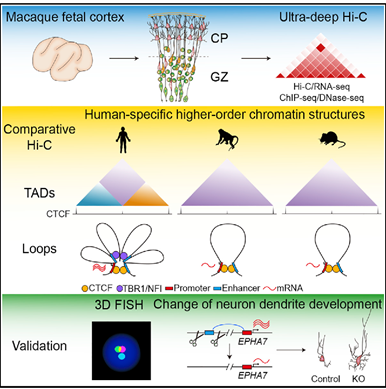02-01-2021 By Quick Biology
Elucidating the regulatory mechanisms of human brain evolution is essential to understanding human cognition and mental disorders. The levels in the genomic sequence, gene expression, pre-mRNA splicing have been extensively studied between human and nonhuman primates. However, the chromatin structure---- this higher order of genome interaction map is less well known, especially across different primates’ species.
In Cell this week, genetic scientist Bing Su from Kunming Institute of Zoology, bioinformatic scientist Cheng Li from Peking University, Mathematics scientist Shihua Zhang from the Academy of Mathematics and Systems Sciences in China, generated multi-omics profiles and constructed a high-resolution map of 3D genome architecture of rhesus macaque during carcinogenesis.
Highlights:
● Identify many human-specific chromatin structure changes, including 499 topologically associating domains (TADs) and 1,266 chromatin loops by comparing the 3D genomes of human, macaque, and mouse brains.
● The subplate lamina shows human-specific regulatory changes during corticogenesis.
● Experimentally prove the human-specific loop regulating EPHA7 affects neuron dendrite development.
This great work highlights the value of comparative 3D genome analyses in dissecting the regulatory mechanisms of brain development and evolution.
Figure 1: Graphical summary of 3D genome analysis in brain evolution (cover image from ref1).

Quick Biology can assist you with Hi-C, ChIP-seq, and RNA-seq for multi-omic analysis. Find More at Quick Biology.
See resource:
1. Luo, X., Liu, Y. et.al. 3D Genome of macaque fetal brain reveals evolutionary innovations during primate corticogenesis Article 3D Genome of macaque fetal brain reveals evolutionary innovations during primate corticogenesis. Cell 1–18 (2021). doi:10.1016/j.cell.2021.01.001
